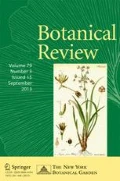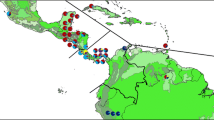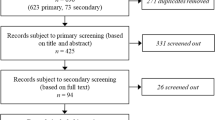Abstract
Living botanic garden plant collections are a fundamental and underutilized worldwide resource for plant conservation. A common goal in managing a botanical living collection is to maintain the greatest biodiversity at the greatest economic and logistic efficiency. However to date there is no unified strategy for managing living plants within and among botanic gardens. We propose a strategy that combines three indicators of the management priority of a collection: information on species imperilment, genetic representation, and the operational costs associated to maintaining genetic representation. In combination or alone, these indicators can be used to assay effectiveness and efficiency of living collections, and to assign a numeric conservation value to an accession. We illustrate this approach using endangered palms that have been studied to varying degrees. Management decisions can be readily extended to other species based on our indicators. Thus, the conservation value of a species can be shared through existing databases with other botanic gardens and provide a list of recommendations toward a combined management strategy for living collections. Our approach is easily implemented and well suited for decision-making by gardens and organizations interested in plant conservation.
Resumen
Las colecciones vivas en jardines botánicos son una parte fundamental y poco utilizada en la conservación de plantas a nivel mundial. Un objetivo común en el manejo de las colecciones botánicas vivas es mantener la mayor biodiversidad al menor costo económico y logístico. Sin embargo hasta ahora no existe una estrategia unificada para el manejo de plantas vivas dentro y entre jardines botánicos. Aquí proponemos una estrategia que combina tres indicadores para establecer prioridades de manejo de una colección: información acerca del riesgo en estado silvestre de la especie, representación genética, y los costos operativos asociados a mantener la representación genética. En combinación o solos, estos indicadores pueden ser utilizados para evaluar la efectividad y eficiencia de las colecciones vivas, y para asignar un valor numérico de conservación a un espécimen. Demostramos esta estrategia con palmas que tienen diversos tipos de estudios e información disponible. Decisiones de manejo basadas en nuestros indicadores se pueden extender y aplicar fácilmente a otras especies de manera similar a como lo demostramos aquí. Además, el valor de conservación de un especie puede ser compartido con otros jardines botánicos utilizando bases de datos pre-existentes y así proveer una serie de recomendaciones hacia el manejo integrado de las colecciones vivas. Nuestra estrategia se puede implementar fácilmente y es apropiada para la toma de decisiones en jardines y organizaciones interesadas en la conservación de recursos en plantas.






Similar content being viewed by others
Literature Cited
BGCI. 2011. GardenSearch Database. Available on the internet at: www.bgci.org/garden_search.php.
Castoe, T. A., A. W. Poole, W. Gu, A. P. J. De Koning, J. M. Daza, E. N. Smith & D. D. Pollock. 2009. Rapid identification of thousands of copperhead snake (Agkistrodon contortrix) microsatellite loci from modest amounts of 454 shotgun genome sequence. Molecular Ecology Resources 10: 341–347.
CBD. 2002. Global strategy for plant conservation. Secretariat of the Convention on Biological Diversity, Quebec.
CEC. 2002. In search of a sustainable palm market in North America, Commission for Environmental Cooperation, North American Agreement for Environmental Cooperation.
Cibrián-Jaramillo, A. 2007. Genetic connectivity in wild populations of understory Chamaedorea palms. PhD dissertation. Columbia University, New York.
——— In press. Genética de la conservación de la palma de sotobosque Chamaedorea ernesti-augustii. In: V. Reynoso Rosales (ed.), Avances y perspectivas en la investigación de bosques tropicales y sus alrededores: Los Tuxtlas. Editorial UNAM, Mexico.
———, C. D. Bacon, N. C. Garwood, R. M. Bateman, M. M. Thomas, S. Russell, C. D. Bailey, W. J. Hahn, S. G. M. Bridgewater & R. DeSalle. 2009. Population genetics of the understory fishtail palm Chamaedorea ernesti-augusti in Belize: high genetic connectivity with local differentiation. BMC Genetics 10: 65.
Crane, P., S. D. Hopper, P. H. Raven & D. W. Stevenson. 2009. Plant science research in botanic gardens. Trends in Plant Science 14: 575–577.
Csencsics, D., S. Brodbeck & R. Holderegger. 2010. Cost-effective, species-specific microsatellite development for the endangered dwarf bulrush (Typha minima) using next generation sequencing technology. Journal of Heredity 101: 789–793.
De los Santos, E. J., P. J. López, R. A. González & M. M. Bolaños. 2003. Proyecto de comercialización de productos forestales no maderables: factores de éxito y fracaso. Palma camedora (Chamaedorea spp.). Comunidad Monte Tinta, Ayotzintepec, Tuxtepec, Oaxaca, México. Grupo Mesófilo A. C., Oaxaca, Mexico.
DeSalle, R. & G. Amato. 2004. The expansion of conservation genetics. Nature Reviews Genetics 5: 702–712.
Dhar, S. 1996. Corypha taliera: endangered palm extinct in the wild. The Palm Journal 130: 10–11.
Dosmann, M. S. 2006. Research in the garden: averting the collections crisis. Botanical Review 72: 207–234.
Eccardi, F. 2003. La palma camedora. Biodiversitas 50: 1–7.
Edwards, K. J., J. H. A. Baker, A. Daly, C. Jones & A. Karp. 1996. Microsatellite libraries enriched for several microsatellite sequences in plants. BioTechniques 20: 758–760.
Enßlin, A., T. M. Sandner & D. Matthies. 2011. Consequences of ex situ cultivation of plants: genetic diversity, fitness and adaptation of the monocarpic Cynoglossum officinale L. in botanic gardens. Biological Conservation 144: 272–278.
Escalera-Más, C. E. 1993. Caracterización de los factores ecológicos relevantes en las comunidades donde el shate (Chamaedorea spp.) es componente, en San Miguel la Palotada, Petén. Facultad de Agronomía, Universidad de San Carlos de Guatemala, Guatemala.
Farnsworth, E. J., S. Klionsky, W. E. Brumback & K. Havens. 2006. A set of simple decision matrices for prioritizing collection of rare plant species for ex situ conservation. Biological Conservation 128: 1–12.
Garwood, N. C., S. G. M. Bridgewater & R. M. Bateman. 2006. Conservation and sustainable management of Chamaedorea palms in Belize. Abstracts Botany 2006 meeting, Chico, California. Available on the internet at: http://2006.botanyconference.org/engine/search/index.php?func=detail&aid=719.
Griffith, P. & C. Husby. 2010. The price of conservation: measuring the mission and its cost. BGJournal 7: 12–14.
———, ———, C. E. Lewis & J. Francisco-Ortega. 2011. Palm conservation at a botanic garden: a case study of the Keys Thatch Palm. Palms 55: 93–101.
Havens, K., E. O. Guerrant & M. Maunder. 2004a. Conservation research and public gardens. Public Garden 19: 40–43.
———, ———, ——— & P. Vitt. 2004b. Guidelines for ex situ conservation collection management: minimizing risks. Pp 454–473. In: E. O. Guerrant, K. Havens, & M. Maunder (eds). Ex situ plant conservation. Island Press with the Society for Ecological Restoration, Washington, DC.
———, ——— & ——— (eds). 2004c. Ex situ plant conservation. Island Press with the Society for Ecological Restoration, Washington, DC.
———, P. Vitt, M. Maunder, E. O. Guerrant & K. Dixon. 2006. Ex situ plant conservation and beyond. BioScience 56: 525–531.
Hird, A. 2010. Center for Plant Conservation Collections Assessment. The Arnold Arboretum of Harvard University, Boston.
——— & M. Dosmann. In Preparation. A conservation assessment model for living plant collections. The Arnold Arboretum of Harvard University. Boston, MA.
Hodel, D. R. 1992. Chamaedorea palms: the species and their cultivation. Allen Press, Lawrence, KS.
——— 2002. In search of a sustainable palm market in North America. T. C. f. E. C. i. N. America. Comission for Environmental Cooperation in North America, Montreal, Quebec.
IUCN. 1994. IUCN red list categories. Prepared by the IUCN Species Survival Commission. IUCN, Gland, Switzerland.
——— 2001. IUCN red list categories. Prepared by the IUCN Species Survival Commission. IUCN, Gland, Switzerland.
Kay, J., A. Strader, V. Murphy, L. Nghiem-Phu, M. Calonje & M. P. Griffith. 2011. Palma Corcho: A Case Study in Botanic Garden Conservation Horticulture and Economics. HortTechnology 21(4): 474–481.
Kramer, A., A. Hird, K. Shaw, M. Dosmann & R. Mims. 2011. Conserving North America’s threatened plants: progress towards target 8 of the Global Strategy for Plant Conservation. Botanic Gardens Conservation International U.S.
Lawrence, S. 2001. Free online availability substantially increases a paper’s impact. Nature 411: 521.
Li, D.-Z. & H. W. Pritchard. 2009. The science and economics of ex situ plant conservation. Trends in Plant Science 14: 614–621.
Martyn, A., D. Merritt & S. Turner. 2009. Seed banking. Pp 63–85. In: C. A. Offord & P. F. Meagher (eds). Plant germplasm conservation in Australia: strategies and guidelines for developing, managing and utilizing ex situ collections, ed. 2nd. Australian Network for Plant Conservation Inc., Canberra.
Maunder, M., B. Lyte, J. Dransfield & W. Baker. 2001. The conservation value of botanic garden palm collections. Biological Conservation 98: 259–271.
McGregor, C. E., C. A. Lambert, M. M. Greyling, J. H. Louw & L. Warnich. 2000. A comparative assessment of DNA fingerprinting techniques (RAPD, ISSR, AFLP and SSR) in tetraploid potato (Solanum tuberosum L.) germplasm. Euphytica 113: 135–144.
Meerow, A. W. 2005. Molecular genetic characterization of new floricultural germplasm. Acta Horticuturae 683: 43–62.
———, R. J. Wisser, J. S. Brown, D. N. Kuhn, R. J. Schnell II & T. K. Broschat. 2002. Analysis of genetic diversity and population structure within Florida coconut (Cocos nucifera L.) germplasm using microsatellite DNA, with special emphasis on the Fiji Dwarf cultivar. Journal of Theoretical and Applied Genetics 106: 715–726.
———, R. J. Schoellhorn & M. Kartuz. 2004. Four cultivars of Iochroma. HortTechnology 39: 194–197.
———, D. Stevenson, J. Moynihan & J. Francisco-Ortega. 2007. Unlocking the coontie conundrum: the potential of microsatellite DNA studies in the Caribbean Zamia pumila complex (Zamiaceae). Memoirs of New York Botanical Garden 98: 484–518.
Meyer, P. S., J. W. Yung & J. H. Ausubel. 1999. A primer on logistic growth and substitution: The mathematics of the loglet lab software. Technological Forecasting and Social Change 61: 247–271.
Mottram, R. & R. Gorelick. 2008. Proposal to require prior deposition of types. Taxon 57: 314.
Namoff, S., C. E. Husby, J. Francisco-Ortega, L. R. Noblick, C. E. Lewis & M. P. Griffith. 2010. How well does a botanical garden collection of a rare palm capture the genetic variation in a wild population? Biological Conservation 143: 1110–1117.
NatureServe. 2009. NatureServe Explorer: An online encyclopedia of life Version 7.1. Arlington, Virginia. Available on the internet at: www.natureserve.org/explorer.
Nei, M. 1978. Estimation of average heterozygosity and genetic distance from a small number of individuals. Genetics 89: 583–590.
Oldfield, S. F. 2009. Botanic gardens and the conservation of tree species. Trends in Plant Science 14: 581–583.
——— 2010. Botanic gardens: modern-day arks. MIT Press, Cambridge.
Oyama, K., R. Dirzo & G. Ibarra-Manríquez. 1992. Population structure of the dominant palm species in the understory of a Mexican lowland rain forest. Tropics 2: 23–28.
Paetkau, D., R. Slade, M. Burden & A. Estoup. 2004. Genetic assignment methods for the direct, real-time estimation of migration rate: a simulation-based exploration of accuracy and power. Molecular Ecology 13: 55–65.
Peakall, R. & P. E. Smouse. 2006. GENALEX 6: genetic analysis in Excel. Population genetic software for teaching and research. Molecular Ecology Notes 6: 288–295.
———, D. Ebert, L. J. Scott, P. F. Meagher & C. A. Offord. 2003. Comparative genetic study confirms exceptionally low genetic variation in the ancient and endangered relictual conifer, Wollemia nobilis (Araucariaceae). Molecular Ecology 12: 2331–2343.
Petit, R. J., A. El Mousadik & O. Pons. 1998. Identifying populations for conservation on the basis of genetic markers. Conservation Biology 12: 844–855.
Powell, W., G. C. Machray & J. A. Provan. 1996. Polymorphism revealed by simple sequence repeats. Trends in Plant Science 1: 215–222.
Radachowsky, J., V. H. Ramos, R. García, J. López & A. Fajardo. 2004. Effects of managed extraction on populations of the understorey palm, xaté (Chamaedorea sp.) in northern Guatemala: Monitoring ecological integrity of the Maya Biosphere Reserve, Péten, Guatemala. Wildlife Conservation Society.
Ramírez, F. 2001. La extracción de palmas camedoras en México: un grave riesgo de perdida de diversidad biológica. Proyecto de Sierra de Santa Marta. Available on the internet at: http://www.raises.org/documentacion/documentos/manejocampesino/ArtPalmas3.pdf.
Reyes-Rodas, R., R. Landivar & R. P. Wilshusen. 2006. El rol de los productos naturales en el desarrollo rural, el alivio a la pobreza y gobernabilidad en el manejo del recurso. El caso de la palma de Xate (Chamaedorea spp) en la region del Peten, Guatemala. USAID.
Rucińska, A. & J. Puchalski. 2011. Comparative molecular studies on the genetic diversity of an ex situ garden collection and its source population of the critically endangered Polish endemic plant Cochlearia polonica E. Fröhlich. Biodiversity and Conservation 20: 401–413.
Santana, Q. C., P. A. M. Coetzee, E. T. Steenkamp, O. X. Mlonyeni, G. N. A. Hammond, M. J. Wingfield & B. D. Wingfield. 2009. Microsatellite discovery by deep sequencing of enriched genomic libraries. BioTechniques 46: 217–223.
Schaal, B. & W. J. Leverich. 2004. Population genetic issues in ex situ plant conservation. Pp 267–285. In: E. O. Guerrant, K. Havens, & M. Maunder (eds). Ex situ plant conservation: supporting species survival in the wild. Island Press with the Society for Ecological Restoration, Washington, DC.
Seaton, P. T., H. Hu, H. Perner & H. W. Pritchard. 2010. Ex situ conservation of orchids in a warming world. Botanical Review 76: 193–203.
Sosa-Martinez, A. 1996. Factibilidad agroecologica para la produccion de palma camedor (Chamaedorea elegans Max) y nuez de macadamia (Maxcadamia integrifolia Maiden &Betche) en los cafetales de la region de Atoyac, Veracruz. M.Sc. Thesis.Instituto de Recursos Naturales, Colegio de Posgraduados, Campus de Veracruz, Veracruz.
Valois, A. C. C. 1994. Genetic resources of palms. Acta Horticulturae 360: 113–120.
Vaxevanidou, Z., S. C. González-Martínez, J. Climent & L. Gil. 2006. Tree populations bordering on extinction: a case study in the endemic Canary Island pine. Biological Conservation 129: 451–460.
Volk, G. M. 2010. Application of functional genomics and proteomics to plant cryopreservation. Current Genomics 11: 24–29.
Vos, P., R. Hogers, M. Bleeker, M. Reijans, T. van de Lee, M. Hornes, A. Frijters, J. Pot, J. Peleman, M. Kuiper & M. Zabeau. 1995. AFLP: a new technique for DNA fingerprinting. Nucleic Acids Research 23: 4407–4414.
Walter, K. & H. Gillette (eds). 1998. 1997 IUCN red list of threatened plants. WCMC IUCN, Gland Switzerland and Cambridge, U.K.
Walters, T. W. & D. S. Decker-Walters. 1991. Patterns of allozyme diversity in the West Indies cycad Zamia pumila (Zamiaceae). American Journal of Botany 78: 436–445.
Watson, G. W., V. Heywood & W. Crowley. 1993. North American botanic gardens. Horticultural Reviews 15: 1–62.
Williams, J. G. K., A. Kubelik, K. J. Livak, J. A. Raflski & S. V. Tingey. 1990. DNA polymorphisms amplified by arbitrary primers are useful as genetic markers. Nucleic Acids Research 18: 6531–6535.
Wyse Jackson, P. S. & K. Kennedy. 2009. The global strategy for plant conservation: a challenge and opportunity for the international community. Trends in Plant Science 14: 578–580.
——— & L. A. Sutherland. 2000. International agenda for botanic gardens in conservation. Botanic Gardens Conservation International, U.K.
Yam, W. T., J. Chua, F. Tay & P. Ang. 2010. Conservation of the native orchids through seedling culture and reintroduction—A Singapore experience. Botanical Review 76: 263–274.
Yatskievych, G. & R. W. Spellenberg. 1993+. In Flora of North America Editorial Committee, eds.. Chapter 10: Plant Conservation in the Flora of North America Region. Volume 1 (http://fna.huh.harvard.edu/Volume/V01/Chapter10). New York and Oxford.
Zarco, E. V. 1999. Patrones biogeográficos y filogeográficos del género Chamaedorea. B.Sc. Thesis. Facultad de Ciencias. Universidad Nacional Autonoma de Mexico, Mexico City.
Acknowledgments
The authors thank Laurie Danielson, Michael Dosmann, Chad Husby, Andrea Kramer, Carl Lewis, Sandra Namoff, Larry Noblick, Sandra Rigotti and Arantza Strader, for their assistance and input; AH acknowledges the Arnold Arboretum Putnam Fellowship, ACJ acknowledges funding from the MBC, the Sackler Institute of Comparative Genomics of the American Museum of Natural History, and the Dorothy and Lewis Cullman Postdoctoral Fellowship; MPG acknowledges the International Palm Society and the Kelly Foundation for generous funding. This is contribution number 221 from the Tropical Biology Program of Florida International University.
Author information
Authors and Affiliations
Corresponding author
Rights and permissions
About this article
Cite this article
Cibrian-Jaramillo, A., Hird, A., Oleas, N. et al. What is the Conservation Value of a Plant in a Botanic Garden? Using Indicators to Improve Management of Ex Situ Collections. Bot. Rev. 79, 559–577 (2013). https://doi.org/10.1007/s12229-013-9120-0
Published:
Issue Date:
DOI: https://doi.org/10.1007/s12229-013-9120-0




